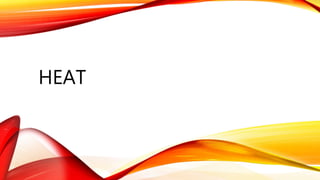
HEAT CAPACITY AND SPECIFIC HEAT
- 1. HEAT
- 2. HEAT CAPACITY • or thermal capacity is a physical property of matter, defined as the amount of heat to be supplied to a given mass of a material to produce a unit change in its temperature. • Material with high heat capacity heats up and cools down slowly because it has to absorb or give off more heat. • Material with low heat capacity heats up and cools down at a faster rate because it has less capacity to absorb or release heat. • Comparing heat capacities of different materials is needed for us to identify the heat properties of substances. • Specific heat of any substance is the ratio of the amoung of heat necessary to raise the temperature of that substance on a certain number of degrees to the amount of heat required to raise the temperature of an equal mass of water the same number of degrees.
- 3. SPECIFIC HEAT • Defined as the number of calories needed to raise the temperature of one gram of a substance 1Co. Meaning, if the specific heat of iron is 0.11 cal/g-Co, one gram requires 0.11 calorie to raise the temperature by one Celsius degree. Table of Specific heat of Some substance Substance Specific Heat Co) Substance Specific Heat Co) Alcohol, ethyl 0.58 Iron or steel 0.11 Aluminum 0.22 Lead 0.031 Brass 0.92 Mercury 0.033
- 4. • Cal/g-Co is the unit of specific heat or Btu/lb-Fo and the SI unit is kJ/kg-K. Q = mc∆T • Formula used in determining the amount of heat needed to raise the temperature of a substance. • Q – quantity of heat gained or given off by an object • m – mass of the object • C – specific heat o ∆T – change in temperature (Tf-Ti) or (T2-T1) Copper 0.093 Silver 0.056 Glass 0.16 Steam 0.48 Gold 0.031 Water 1.00 Ice 0.5 Zinc 0.092
- 5. LATENT HEAT • Matter exist in different states (solid, liquid, gas, and plasma) because of the amount of energy they have. • They depend on the temperature and pressure exerted on them. • There is a changing in its states if there is absorption and release of a certain amount of heat that affects the arrangement of molecules. • For example: applying heat to ice – changing solid state to liquid state to gas state applying heat to solid state will increase the motion of the molecules which then becomes liquid, further add sufficient heat to liquid will take to a form of steam (gas), adding more heat molecules will break into ions and electrons that give you plasma. In reverse (removing heat, slows down molecules)
- 7. LATENT HEAT OF FUSION • Amount of heat absorb during the process • If object undergo fusion solid for instance, it will turn into a liquid. • Also refers to the melting process
- 8. LATENT HEAT SOLIDIFICATION • Amount of heat released in the process • Removing heat from the liquid and turns it to solid • Also refers to the freezing process
- 9. • LATENT HEAT OF FUSION = 80 calories per gram = 80 cal/g = 334.72 J/g • Heat Q required to melt a solid object with mass m is: Q = mLf Lf = the latent heat of fusion
- 10. Question: The heat of fusion of water is 334 J/g. How much energy is required to melt 50 grams of ice into liquid water? Given: m = 50 grams; Lf = 334 J/g Solution: Q = m · Lf Q = (50 g) · (334 J/g) Q = 16700 J ANSWER: Q= 16.7 kJ EXAMPLE #1
- 11. Question: If it takes 41000 joules of heat to melt 200 grams solid copper to liquid copper, what is the heat of fusion of copper? GIVEN: m = 200 g; Q = 41000 J; Lf =? SOLUTION: Q = m·Lf 41000 J = (200 g) · Lf Lf = 41000 J/200 g Lf = 205 J/g Answer: The heat of fusion of copper is 205 J/g. EXAMPLE #2
- 12. LATENT HEAT OF VAPORIZATION AND CONDENSATION HEAT OF VAPORIZATION - Amount of heat needed to change a unit mass of the substance from liquid to gas without a change in temperature. HEAT OF CONDENSATION – amount of heat required to change the unit mass of substance from gas to liquid with a change of temperature.
- 13. • Heat of vaporization and condensation = 540 calories per gram at 100oC = 2259.36 J/g Q = mLv Lv – latent heat of vaporization
- 14. QUESTION: Determine the amount of heat released by nitrogen to change phase from vapor to liquid. Heat of vaporization for nitrogen = 200 x 103 J/kg GIVEN : Mass (m) = 1 gram = 1 x 10-3 kg; (LV) = 200 x 103 J/kg Solution : Q = m LV Q = (1 x 10-3 kg)(200 x 103 J/kg) ANSWER: Q = 200 Joule EXAMPLE #1
- 15. Question: The heat of vaporization of water is 2259 Joules/gram or 540 calories/gram. What energy in Joules is required to convert 50 grams of water into steam? How much energy in calories? GIVEN: m = 50 grams; Lv = 2257 J/gram SOLUTION: Q = m · Lv Q = (50 g) · (2257 J/g) Q = 112850 J = 112.85 kJ In calories: Lv = 540 cal/g Q = m · Lv Q = (50 g) · (540 cal/g) Q = 27000 cal = 27 kcal Answer: It takes 112850 Joules or 27000 calories of heat to convert 50 grams of liquid water into gaseous water or steam. EXAMPLE #2